BBS era
1959
- The first commercially available Bell 101 modem from AT&T Corporation was originally introduced in 1958. It could transmit data over a regular telephone line at a rate of 110 baud (11 bytes/s).
1962
- The Bell 103 modem increased the transmission data speed to 300 baud (30 bits/s).
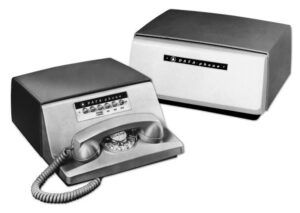
1973
The first virtual protosocial network was created as the Community Memory Project in 1973 at Leopold’s Records in Berkeley, California. Four terminals allowed users to post messages to each other. It existed in some form until the early 1990s.1
1977
June 10, 1977
The first mass-produced Apple II computer for $1,298 ($6,737 in 2024) from Apple Computer, designed by Steve Wozniak, was released. With the use of a modem, he enabled the creation of the first virtual social communities and the first pirate scene.
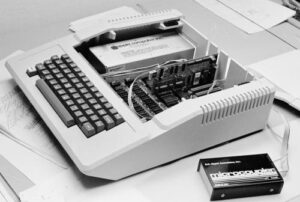
August 3, 1977
The Tandy TRS-80 was launched at an introductory price of $599 ($3,109 in 2024) as a major competitor to the Apple II.
Late Summer, 1977
Ward Christensen wrote MODEM.ASM terminal program for CP/M users to work with Dave Jaffe’s “BYE” routine, which allowed remote users to call and record data to diskette. Dave Jeff is also the author of the XMODEM file transfer protocol.2
1978
February 16, 1978
February 16, 1978 is the official creation of the first CBBS software (Randy named it Computer Elite’s project C – Communications), when it was published by authors Ward Christensen and Randy Suess. They sold about 200 licenses for the first version at a price of $50 ($260 in 2024).3
1980
January 29, 1980
The Sinclair ZX80 home computer launched, priced from £79.95 to £99.95 (£430 – £537 in 2024) depending on equipment. The follow-up Sinclair ZX81 was released on March 5, 1981, and the most successful model, the Sinclair ZX Spectrum, on April 29, 1982.
January 29, 1980
The first computer to reach a million sales, Commodore’s VIC-20, was released on June 20, 1980 (Japanese market). The VicModem of March 1982 for the VIC-20 was the first modem to sell over a million units, helped by the sub-$100 price tag.
1981
August 12, 1981
Original IBM Personal computer (Model 1150) with a price of $1,565 ($5415 in 2024) for a configuration with Intel 8088 CPU, 16 KB RAM, CGA graphics card, two 5¼-inch floppy disk drives and keyboard.
1982
August 16, 1982
The Commodore C64 was the most successful (up to 17 million units sold) home computer of the 1980s. The introductory price was $595 for the equipment 64 KB RAM, 20 KB ROM, 320×200 pixels in 16 colors, external cassette drive or floppy disk drive.
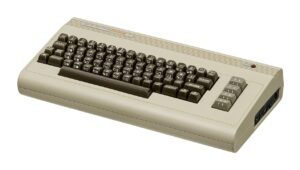
1983
The first known hacking attack by 6 young people acting as the 414s group (telephone area 414 for Milwaukee, Wisconsin) aged 16 to 22. During 1983, they managed to remotely access computers at the Los Alamos National Laboratory and Sloan-Kettering Cancer Center via telephone lines.4
1984
December 24, 1984
The beginning of the first worldwide network FidoNET outside the military or academia, created by Tom Jennings in June 1984. The first intercontinental FidoNet message was sent from Jakarta (Indonesia) to St. Louis (Missouri, USA) at December 24, 1984.5
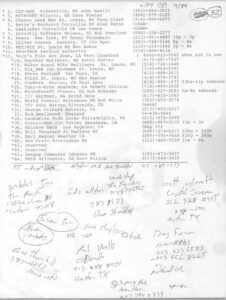
1985
October 24, 1985
The most famous warez group Razor 1911 was born in Norway originally as a demo group for the Commodore C64.
1986
October 21, 1986
The Electronic Communications Privacy Act of 1986 (ECPA) was passed by the United States Congress and signed into law by US President Ronald Reagan. The direct cause was a pirated broadcast on HBO’s broadcast band in protest against their pricing policy. A nearly 5-minute blackout on April 27, 1986, was caused by John R. MacDougall aka Captain Midnight.
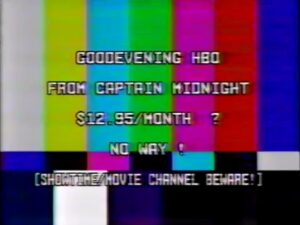
1990
March 1, 1990
The U. S. Secret Service confiscated the computer equipment of Steve Jackson Games BBS, creator of well-known role-playing games such as GURPS or Munchkin. After the fatal trial, all her equipment was returned and the US paid her attorney’s fees and damages.
May 9, 1990
Operation Sundevil was the most extensive crackdown by the U.S. Secret Service in 1990 targeting phreakers involved in credit card fraud and telecommunications fraud. Approximately 25 BBSs and up to 23,000 floppy disks were seized.
1995
April 19, 1995
Assassin’s Guild BBS (13 computers, 11 modems, 9 GB online data and 40 GB offline data storage dating back to 1992) is seized by U.S. Marshals. Board was world headquarters of Razor 1911, Pirates With Attitude and Malice. A year later, sysop Blackhawk (real name Scott Morris, 25 years old) agreed to a deal to pay $73,000 in cash and forfeit over $40,000 worth of hardware.
Internet Era
2001
December 11, 2001
U.S. law enforcement carried out 3 operations during the year. The largest was Operation Buccaneer targeting the Drink or Die (DOD) warez group. Tours have been conducted in the USA, UK, Australia, Norway, Sweden, and Finland. John Sankus is sentenced to 46 months and Barry Ericson to 33 months in prison.
Another Operation Bandwith resulted in 30 indictments when state authorities secretly ran a warez site with illegal content for 2 years. The last Operation Digital Piratez resulted in 9 charges.6
- Bo Doub, “Community memory: Precedents in social media and movements” Computer History Museum, February 23, 2016, https://computerhistory-org.translate.goog/blog/community-memory-precedents-in-social-media-and-movements/. ↩︎
- Ward Christensen and Randy Suess, “The Birth of the BBS”, last modified 1989, last accessed August 21, 2024, https://www.chinet.com/html/cbbs.php. ↩︎
- Ward Christensen and Randy Suess, “The Birth of the BBS”, last modified 1989, last accessed August 21, 2024, https://www.chinet.com/html/cbbs.php. ↩︎
- Michael T. Vollmann, The 414s: The Original Teenage Hackers, CNNFilms, 2015, https://vimeo.com/502242358. ↩︎
- Tom Jennigs et all, Fidonews ,Volume 1, Number 4, http://eljaco.se/FILES/fnews/FNEWS_84.ZIP ↩︎
- “Federal law enforcement targets international internet piracy syndicates. Multiple Enforcement Actions Worldwide Snare Top “Warez” Leadership”, United States Department of Justice, December 11, 2001, https://www.justice.gov/archive/opa/pr/2001/December/01_crm_643.htm ↩︎
